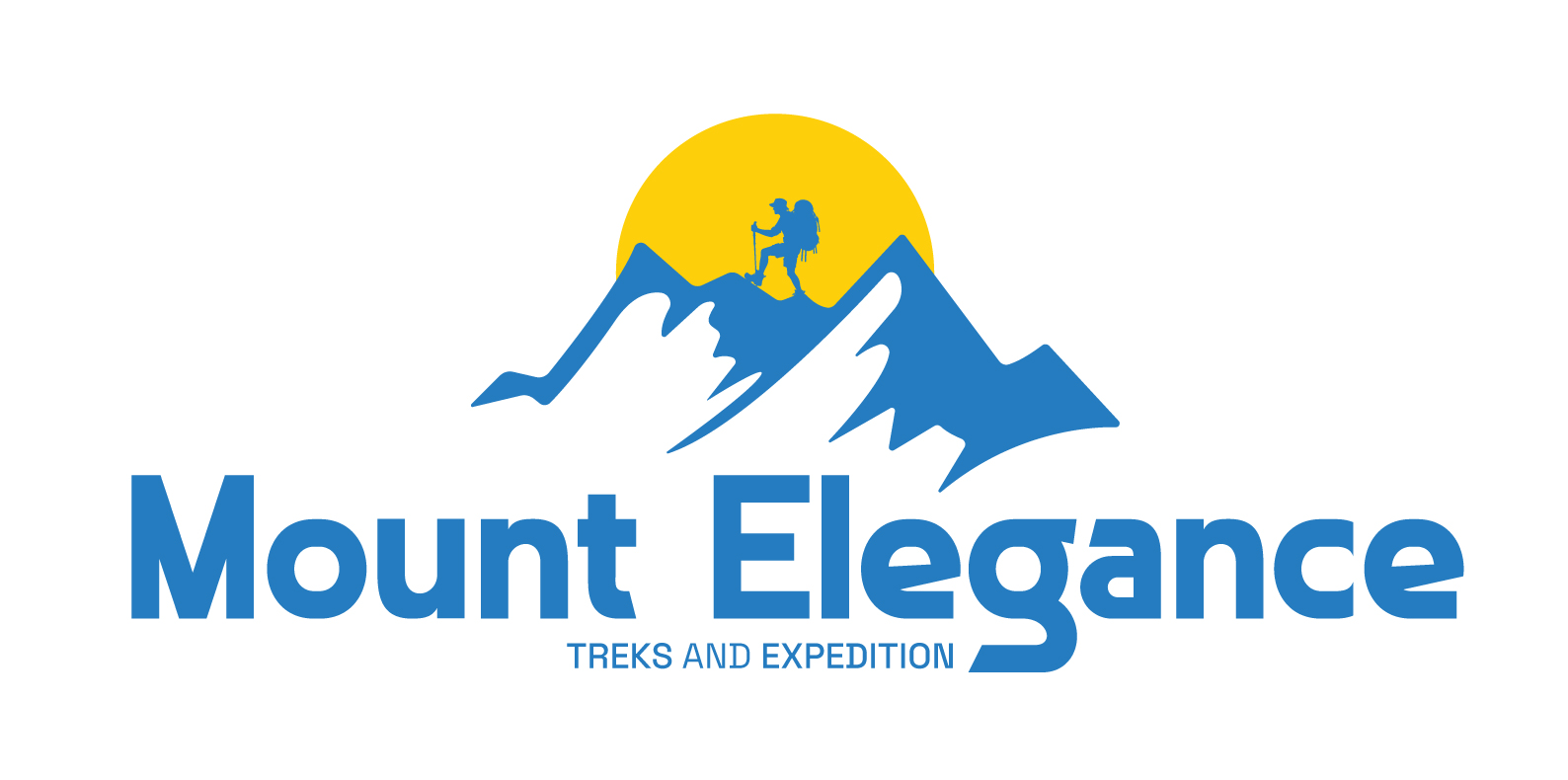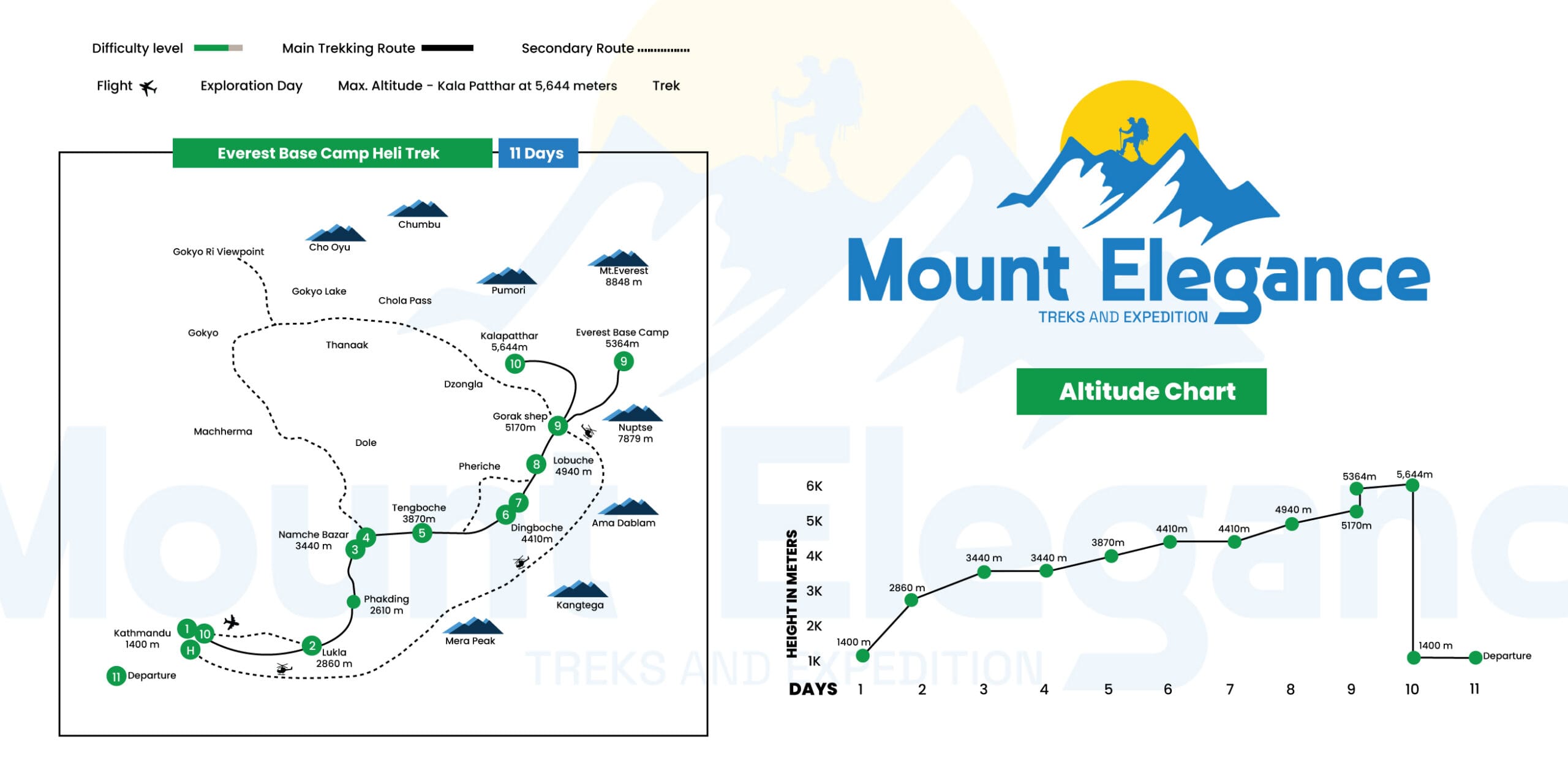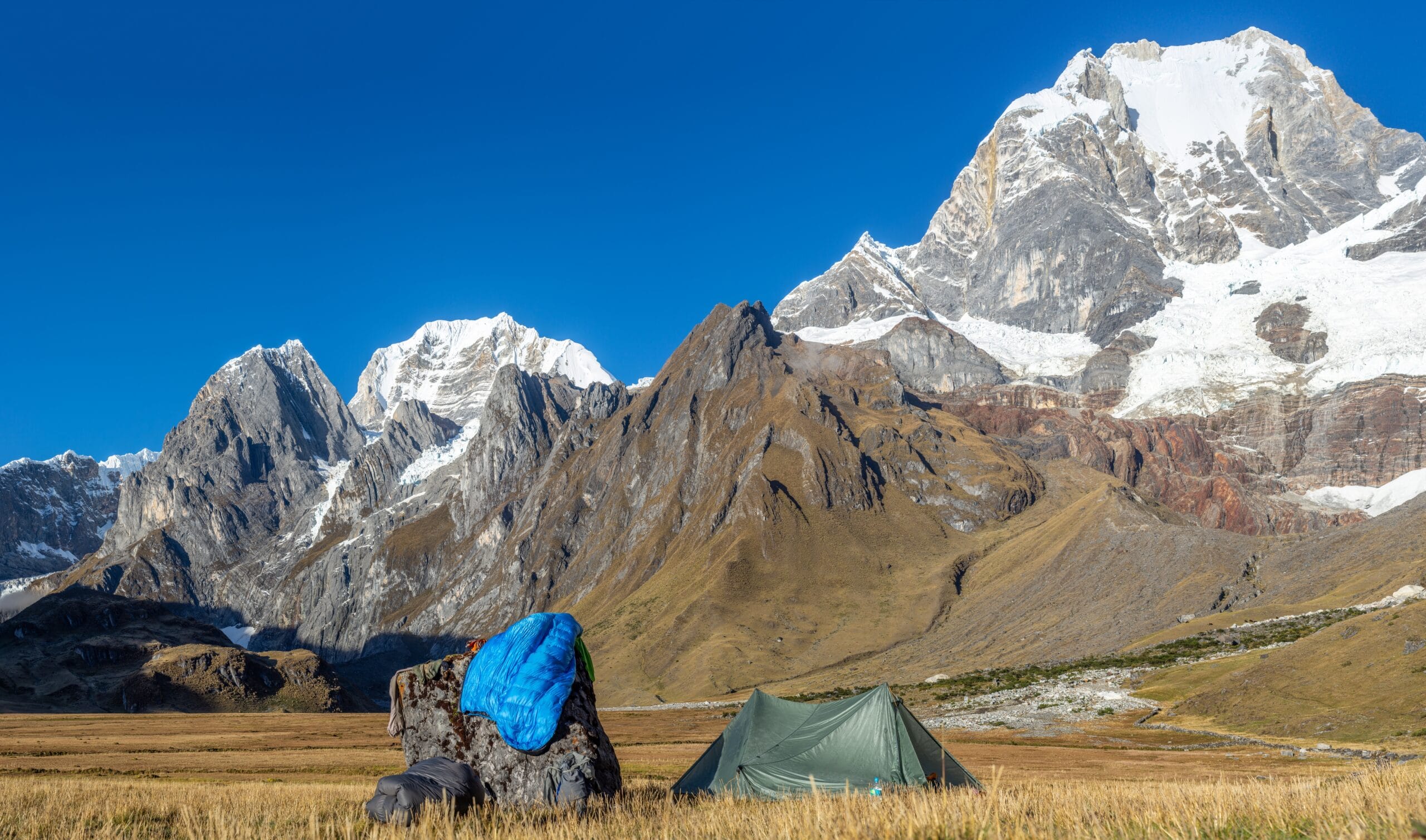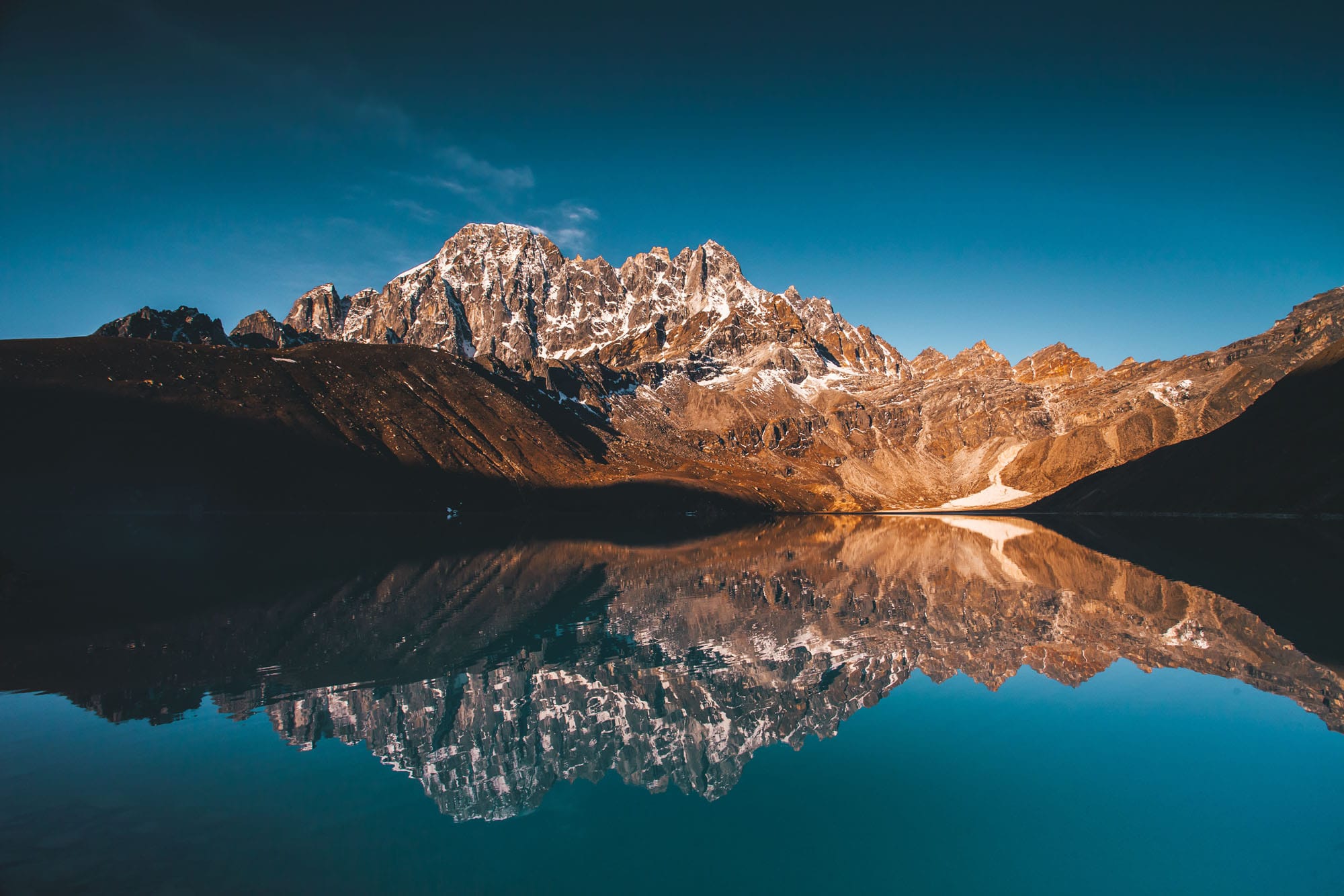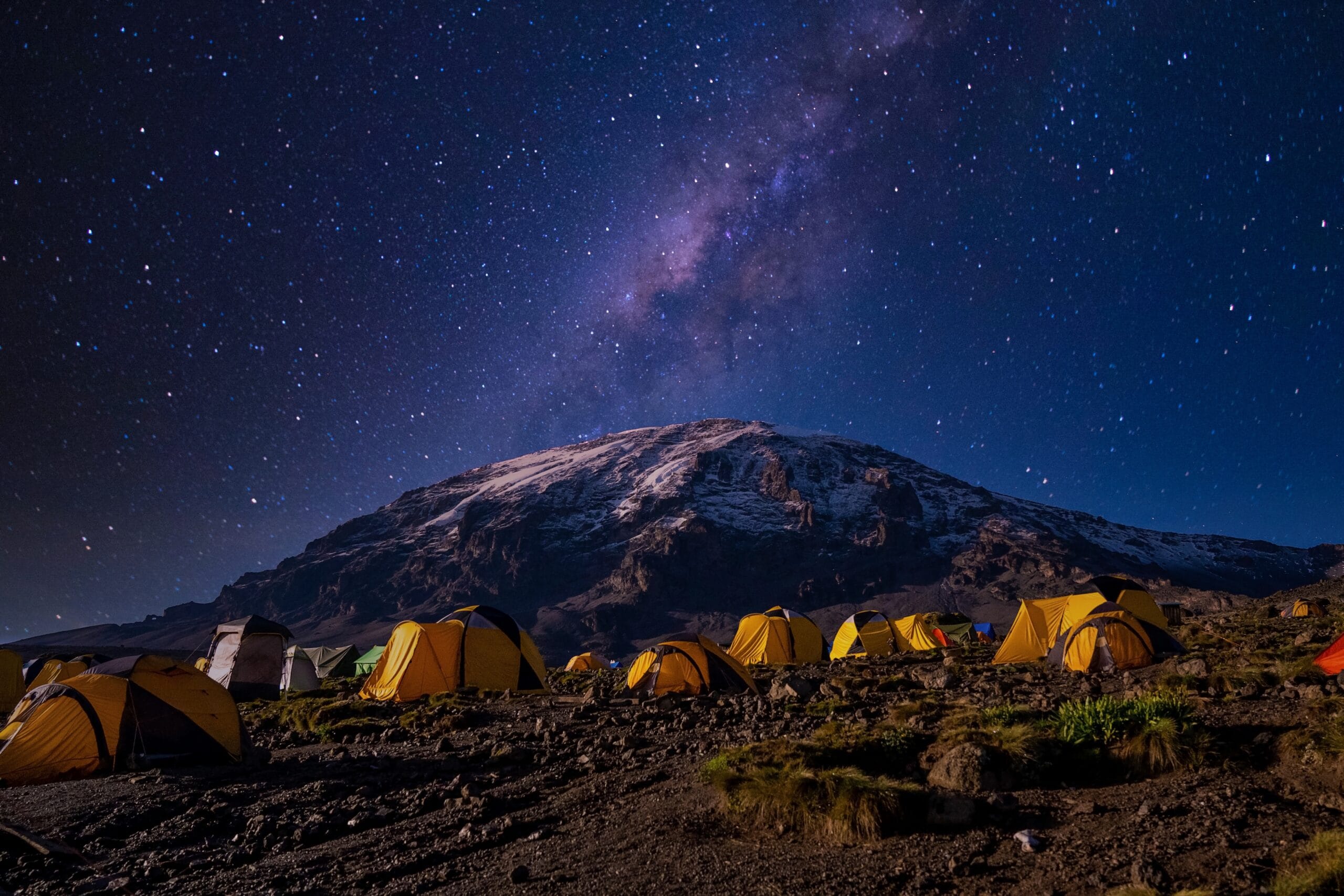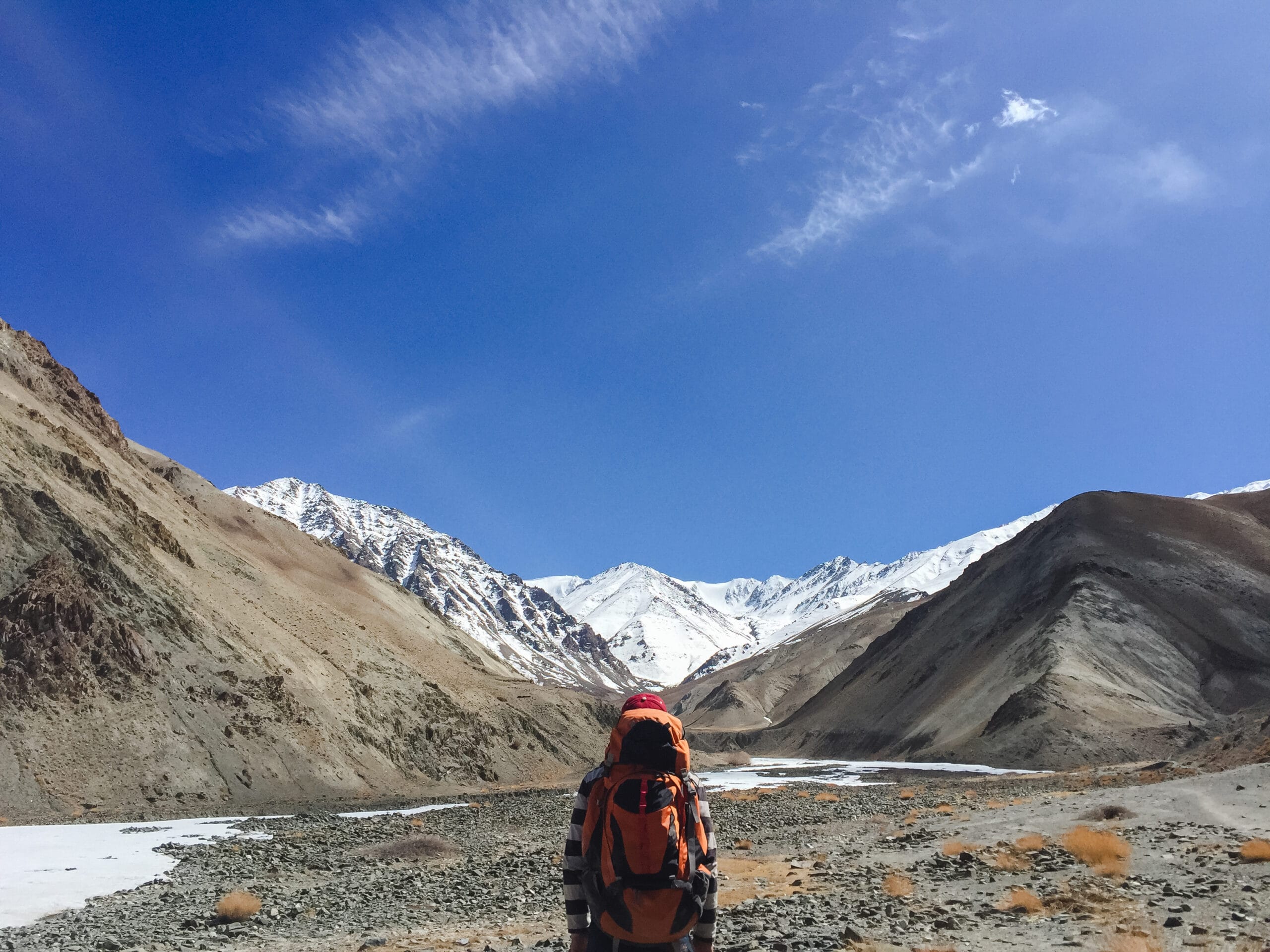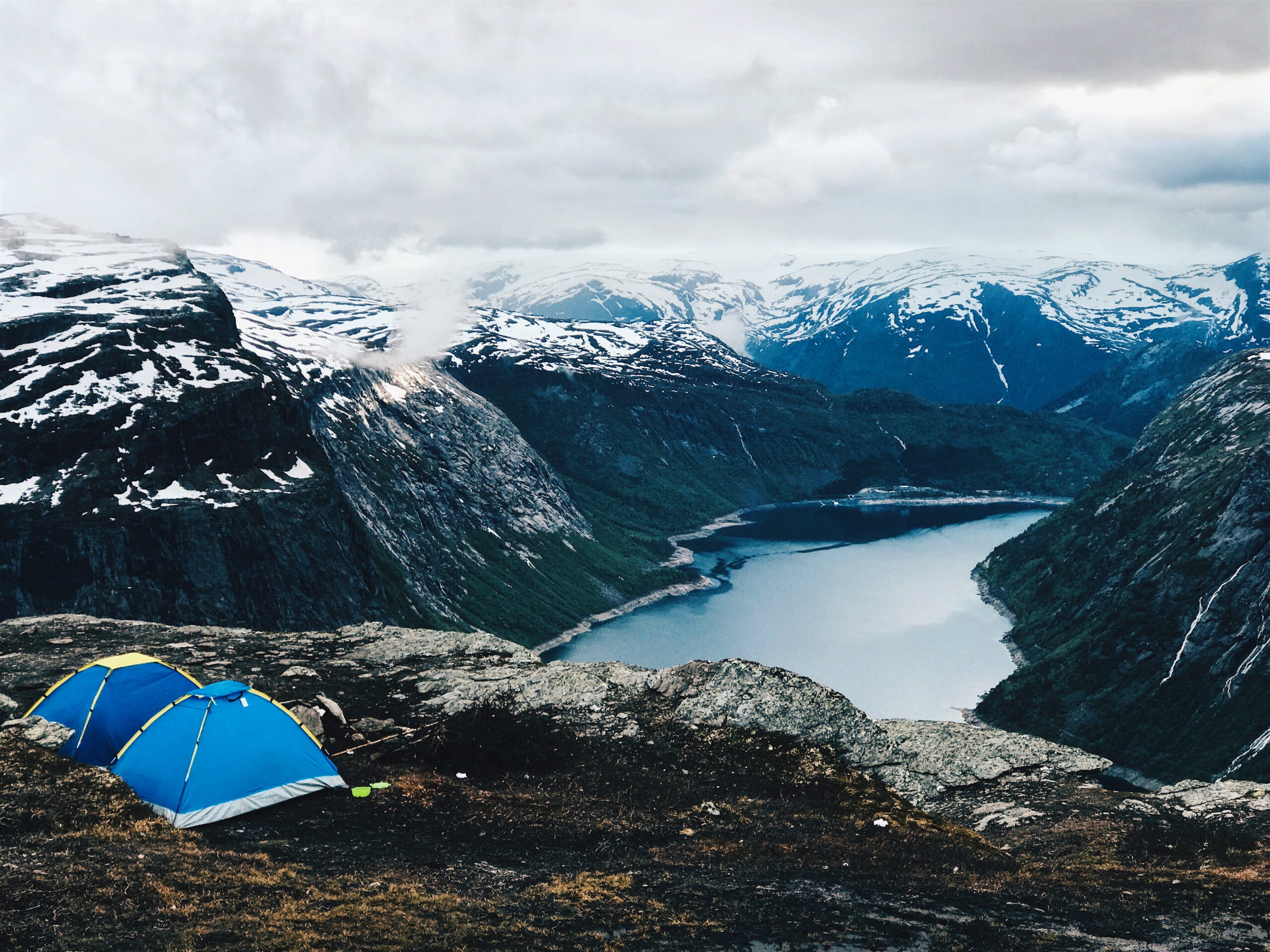Everest Base Camp Helicopter Trek – 11D
Best Season
Highest Altitude
Trip Overview
The Everest Base Camp Helicopter Trek is the perfect blend of adventure and convenience. The Everest Base Camp Helicopter Trek offers trekkers the chance to explore the majestic Everest region without the need to retrace their steps. This 12-day adventure is designed for those who wish to reach the iconic Everest Base Camp and then enjoy a scenic helicopter ride back. This unique return provides a stunning perspective of the Himalayas.
The Journey Begins: From Kathmandu to Lukla
Your journey starts with a thrilling flight from Kathmandu to Lukla, the gateway to the Everest region. From here, the trek takes you through the heart of the Khumbu Valley. You’ll walk along trails surrounded by some of the world’s highest peaks. As you progress, you’ll pass through vibrant Sherpa villages, each offering a glimpse into the rich culture and traditions of the local people.
Exploring Namche Bazaar and Tengboche Monastery
One of the trek’s highlights is a stop at Namche Bazaar, known as the Sherpa capital. This bustling hub serves as an acclimatization point and a gateway to explore the region’s culture. As you trek further, you’ll visit the Tengboche Monastery. This is one of the most important spiritual centers in the region, set against the backdrop of towering peaks like Ama Dablam. The peaceful ambiance and stunning views make this a memorable stop on your journey.
Reaching Everest Base Camp and Kala Patthar
Continuing onward, the trek leads you to the ultimate destination: Everest Base Camp, at 5,364 meters. Here, you’ll stand at the foot of the world’s highest mountain, surrounded by awe-inspiring glaciers and icefalls. But the adventure doesn’t end there. The following morning, you’ll hike to Kala Patthar (5,644 meters) for a breathtaking sunrise view of Mount Everest. This vantage point offers unparalleled panoramic views of the Himalayas, making it one of the highlights of the trek.
The Thrilling Helicopter Ride Back
After soaking in the views from Kala Patthar, you’ll board a helicopter at Gorak Shep for an exhilarating flight back to Lukla. This helicopter ride provides stunning aerial views of the Himalayas, offering a unique end to your journey.
Trip Highlights:
- Trek through the heart of the Khumbu region, experiencing the Sherpa culture.
- Visit iconic sites such as Namche Bazaar, Tengboche Monastery, and Kala Patthar.
- Reach Everest Base Camp at 5,364 meters.
- Enjoy a thrilling helicopter ride back to Lukla with stunning aerial views of the Himalayas.
- Experience the hospitality of Sherpa culture and stay in cozy teahouses.
- Accommodation: Stay in comfortable teahouses during the trek; standard hotels in Kathmandu.
- Meals: Full-board meals (breakfast, lunch, and dinner) during the trek; breakfast in Kathmandu.
- Luggage: Porters provided for luggage transport (up to 15 kg per person).
- Internet/WiFi, Electricity, and Water: Available at most lodges along the trekking route (additional charges may apply); complimentary WiFi in Kathmandu hotels.
Essential Items:
- Base Layers: Thermal top and bottom
- Insulation: Fleece jacket and down jacket
- Outer Layer: Waterproof jacket and pants
- Trekking Clothes: Some pairs of trekking pants, quick-dry shirts
- Footwear: Trekking boots, camp shoes/sandals
- Headwear: Sun hat, warm hat, neck gaiter
- Hand-wear: Lightweight gloves, insulated gloves
Accessories: Sunglasses, sunscreen, lip balm , headlamp with extra batteries , trekking poles ,50-60L backpack + daypack
Personal Items: Hygiene essentials (toothbrush, toothpaste, wet wipes), Quick-dry towel ,Water bottle or hydration system (2L capacity), Snacks (energy bars, nuts)
Medical Kit: Personal medications, basic first aid, altitude sickness pills
Documents: Passport, trekking permits, travel insurance
Optional: Camera, power bank, Lightweight sleeping bag
Lukla Flight and Cancellation:
Flights to Lukla, the gateway to the Everest region, are a thrilling part of the Everest trekking experience. These flights usually operate from either Kathmandu or Ramechhap, depending on the season and air traffic regulations. Due to the high-altitude terrain and unpredictable mountain weather, Lukla flights are highly sensitive to weather conditions and are frequently delayed or even canceled—especially during the monsoon and winter seasons. We strongly advise trekkers to keep at least 1-2 buffer days in their itinerary to accommodate potential flight disruptions. In case of prolonged cancellations, helicopter charter options may be available at additional cost.
At Mount Elegance Trek and Expedition, we closely monitor flight schedules and weather updates to keep you informed and assist with alternative arrangements as needed, ensuring your journey remains smooth and stress-free.
Itinerary
- Drive Duration: 30-45 minutes
- Meal: Breakfast
- Highest Altitude: Kathmandu (1,400m/ 4,600ft)
Upon arrival at Tribhuvan International Airport in Kathmandu, you will be greeted by your local representative and transferred to a luxurious hotel in the city’s cultural heart. This bustling capital of Nepal is a vibrant blend of ancient traditions and modern charm. As you drive through the city, you’ll see a colorful mix of pagoda-style temples, busy markets, and colonial-era buildings. After check-in, unwind with a welcome drink, enjoy the tranquil setting of your hotel, or opt for a relaxing spa treatment to recover from your journey.
In the evening, attend a welcome briefing with your guide, who will provide an overview of the trek, answer any questions, and review essential gear. This is also a great opportunity to meet fellow trekkers if you’re part of a group. A traditional Nepali welcome dinner follows, featuring local dishes like momo (dumplings), dal bhat (lentil curry), and sel roti. Return to your hotel for a restful night as you prepare for the thrilling days ahead amidst the Himalayas.
- Flight Distance: 138 km (86 miles)
- Flight Duration/ Trek Duration: 25-30 minutes / 3-4 hours
- Meal: Breakfast, Lunch &Dinner
- Highest Altitude: Lukla (2,860m/9,383ft) & Phakding (2,610m/8,563ft)
Start your morning with an early transfer to Kathmandu’s domestic airport, where you’ll board a scenic flight to Lukla. This short but unforgettable flight provides your first aerial glimpses of the snow-capped Himalayas, including Everest itself. Landing at Lukla’s Tenzing-Hillary Airport, nestled against dramatic cliffs, marks the beginning of your trek. Upon arrival, you’ll meet your porters and start the gentle trek to Phakding, descending slightly through pine forests and alongside the glacial Dudh Koshi River.
The trail leads past traditional stone houses, fluttering prayer flags, and mani walls carved with sacred inscriptions. You’ll cross your first of many suspension bridges and enjoy serene views of the surrounding valleys and waterfalls. After a few hours of easy trekking, arrive in the riverside village of Phakding. Check into a luxury teahouse lodge, where you can enjoy a warm meal and a cozy evening by the fire, surrounded by the peaceful sounds of nature.
- Trek Distance: 10 km (6.2 miles)
- Trek Duration: 5-6 hours
- Meal: Breakfast, Lunch & Dinner
- Highest Altitude: Namche Bazaar (3,440m /11,283ft)
After breakfast in Phakding, you’ll continue your trek northward through beautiful pine and rhododendron forests, gradually ascending toward Namche Bazaar. The trail follows the Dudh Koshi River and passes through quaint villages like Benkar and Monjo, where you’ll register your permits at the entrance of Sagarmatha National Park. From here, the path becomes more challenging, with a series of suspension bridges and a steep uphill climb leading to Namche.
As you ascend, you may catch your first glimpses of Mount Everest, along with other Himalayan giants like Thamserku and Kusum Kanguru. The final stretch to Namche involves a strenuous but rewarding ascent through winding switchbacks. Once you reach Namche Bazaar—a bustling Sherpa town nestled in a natural amphitheater—you’ll check into a deluxe mountain lodge offering panoramic views, hot showers, and hearty meals. Spend your evening acclimatizing and exploring the lively streets lined with bakeries, shops, and quaint cafés.
- Meal: Breakfast, Lunch & Dinner
- Highest Altitude: Namche Bazaar (3,440m /11,283ft)
Today is a scheduled acclimatization day to help your body adjust to the altitude. After a leisurely breakfast, embark on a short but steep hike to the Everest View Hotel, the highest-placed hotel in the world. From this vantage point, enjoy awe-inspiring views of Everest, Lhotse, Nuptse, and the elegant Ama Dablam. This hike serves the dual purpose of offering mesmerizing scenery while aiding acclimatization through “climb high, sleep low” strategy.
Return to Namche in the afternoon for a relaxed exploration of the town. You can visit the Sherpa Culture Museum to learn about the region’s mountaineering heritage or stop by the local monastery for a quiet moment of reflection. If you’re up for it, enjoy a fresh pastry from a German bakery or browse handmade souvenirs crafted by local artisans. The evening is yours to rest and refuel, as tomorrow you continue deeper into the heart of the Khumbu region.
- Trek Distance: 10 km (6.2 miles)
- Trek Duration: 5-6 hours
- Meal: Breakfast, Lunch & Dinner
- Highest Altitude: Tengboche (3,870m /12,694ft)
Leaving Namche behind, your journey continues along a scenic trail that offers exceptional views of Everest, Lhotse, and Ama Dablam. The path gently ascends before descending to the Dudh Koshi River, crossing it via a suspension bridge. From here, a challenging uphill climb through pine and juniper forests takes you to the spiritual village of Tengboche. Known for its serene atmosphere, Tengboche is home to the region’s largest and most significant monastery.
Upon arrival, you’ll have the chance to visit Tengboche Monastery, a majestic structure perched on a hilltop with a panoramic backdrop of towering Himalayan peaks. Inside, witness the vibrant murals, spinning prayer wheels, and monks chanting ancient Buddhist mantras. After soaking in the spiritual energy and awe-inspiring views, retire to your teahouse for a warm meal and quiet evening under a sky filled with stars.
- Trek Distance: 11 km (6.8 miles)
- Trek Duration: 6-7 hours
- Meal: Breakfast, Lunch & Dinner
- Highest Altitude: Dingboche (4,410m /14,470ft)
After morning prayers and breakfast, begin your trek through rhododendron forests that soon give way to more alpine terrain. The route takes you through charming villages like Debuche and Pangboche, the latter being one of the oldest Sherpa settlements in the region. En route, take in the increasingly rugged scenery as trees become sparse and the terrain more barren and dramatic.
Crossing the Imja Khola River on a sturdy bridge, the trail continues with a steady climb to Dingboche. Surrounded by stunning views of Lhotse, Ama Dablam, and Island Peak, Dingboche is a scenic high-altitude village nestled in the Imja Valley. Here, fields are protected by stone walls to shield crops from cold winds and grazing animals. Settle into your teahouse, where you'll rest and refuel in preparation for the next acclimatization day.
- Meal: Breakfast, Lunch & Dinner
- Highest Altitude: Dingboche (4,410m /14,470ft)
With the increasing altitude, today is designated for acclimatization. After breakfast, embark on a short hike to Nangkartshang Hill (5,100m), which offers unparalleled views of Makalu, Lhotse, and Cho Oyu. This steep but rewarding climb allows your body to adapt to the thinning air and enhances your chances of safely reaching higher altitudes in the coming days.
After returning to Dingboche, spend the afternoon relaxing in your teahouse or strolling around the village. Observe daily life in the high Himalayas, interact with locals, or simply enjoy the peacefulness of your alpine surroundings. The crisp mountain air and spectacular vistas make Dingboche a truly memorable stop on your journey.
- Trek Distance: 8 km (5 miles)
- Trek Duration: 5-6 hours
- Meal: Breakfast, Lunch & Dinner
- Highest Altitude: Lobuche (4,940m /16,207ft)
The trail today leads through a remote, desolate landscape known as the Thukla Pass. After a hearty breakfast, trek uphill toward the steep moraine of the Khumbu Glacier. The path gradually ascends through Dughla, where you’ll pause to pay respects at a memorial site dedicated to climbers who lost their lives on Everest—rows of stone chortens adorned with prayer flags create a somber yet inspiring scene.
Continue your climb over the glacial terrain until you reach Lobuche, a small settlement tucked beside towering peaks. Though rugged, your teahouse offers essential comforts and warmth. From this altitude, the views are breathtaking, especially as the sunset paints the ice fields and mountains in hues of gold and pink. Rest well tonight, as tomorrow takes you to Everest Base Camp.
- Trek Distance: 14.9 km (9.2 miles)
- Trek Duration: 6-7 hours
- Meal: Breakfast, Lunch & Dinner
- Highest Altitude: Everest Base Camp (5,364m /17,598ft)
Today is the day you reach the iconic Everest Base Camp. Depart early and make your way toward Gorak Shep, the last outpost before Base Camp. The path winds along the Khumbu Glacier, surrounded by glistening ice pinnacles and towering peaks. After a short rest and refreshment stop in Gorak Shep, continue the final stretch to Everest Base Camp.
Reaching Base Camp is an emotional and rewarding experience. Take time to celebrate and capture the moment with photos amidst colorful prayer flags and dramatic glacial landscapes. Though you won’t see the summit of Everest from here, the sense of standing at the base of the world’s highest mountain is surreal. After soaking in the achievement, return to Gorak Shep for the night.
- Trek Distance: 2.5 km (1.5 miles)
- Trek Duration/ Flight Duration: 3-4 hours / 1 hours
- Meal: Breakfast, Lunch & Dinner
- Highest Altitude: Kala Patthar (5,644m/18,517ft)
Wake before dawn to summit Kala Patthar, a renowned vantage point offering the best panoramic views of Everest and the surrounding Himalayan range. The hike is challenging but short, and the reward is immense. As the sun rises over Everest, witness a spectacle of color and light on the snow-capped giants—an unforgettable highlight of your trek.
After descending back to Gorak Shep, prepare for your dramatic exit from the mountains. Board a chartered helicopter and soar above the vast glacier fields, deep valleys, and rugged peaks on your return journey to Kathmandu. The flight offers a bird’s-eye view of the terrain you’ve conquered on foot. Upon arrival, transfer to your luxury hotel where you can rest, enjoy a hot shower, and reflect on your incredible adventure.
- Drive Duration: 30-45 minutes
- Meal: Breakfast
- Altitude: Kathmandu (1,400m/ 4,600ft)
Today marks the end of your Himalayan adventure. Depending on your flight schedule, enjoy a leisurely breakfast at your hotel. You may opt for some last-minute shopping in Thamel’s vibrant markets or visit nearby cultural landmarks such as the Garden of Dreams or the sacred Swayambhunath Stupa. Take in the final moments of Kathmandu’s charm—its chaotic beauty, its spiritual calm, and its warm, hospitable people.
Your private transport will take you to Tribhuvan International Airport for your onward journey. As you board your flight, carry with you the memories of breathtaking peaks, serene monasteries, and the unmatched spirit of the Everest region. The Everest Base Camp Helicopter Trek isn’t just a journey to the top of the world—it’s a transformative experience that stays with you long after you’ve left the mountains behind.
Book Now
Send an Inquiry
Got A Question?

Mr. Shishir Dhakal
Price Inclusion
- Transfer to the airport for your departure flight.
- Airport pickups and drop-offs in Kathmandu.
- Accommodation in a 3-star hotel in Kathmandu with breakfast.
- Teahouse accommodation during the trek.
- All meals (breakfast, lunch, and dinner) during the trek.
- Domestic flight (Kathmandu – Lukla – Kathmandu).
- Helicopter return from Everest Base Camp to Lukla.
- An experienced, English-speaking, government-licensed guide.
- Porters to carry luggage (1 porter for 2 trekkers).
- Sagarmatha National Park permits and TIMS.
- Seasonal fresh fruit as dessert every evening after dinner.
- Mount Elegance free Tshirt and Route map.
- Complimentary first aid box (Guide will carry during trekking).
- Oximeter to measure the Oxygen (For awareness of the high altitude sickness).
- All government and local taxes.
- Duffel bag and sleeping bag for trekking (Should be returned after trek completion).
- Farewell dinner at the end of the trek.
- Certificate after trek completion.
Price Exclusion
- International airfare.
- Nepal visa fee.
- Lunch and dinner in Kathmandu.
- Travel and rescue insurance.
- Personal expenses (laundry, phone calls, etc.).
- Tips for guides and porters.
Additional Information
Trip Map
Meals and Accommodation on Everest Base Camp Helicopter Trek
In Kathmandu, you will stay in a standard hotel equipped with modern amenities, including complimentary WiFi. This comfortable accommodation allows you to relax and prepare for the trek.Along the trek, you’ll stay in teahouses that provide cozy rooms with basic amenities. Rooms are typically shared or twin-sharing setups, with communal dining areas where you can enjoy meals and socialize with other trekkers. Facilities like hot showers, charging outlets, and WiFi are available in most lodges, though additional charges may apply.
Full-Board Meals including Breakfast, lunch, and dinner are provided during the trek, featuring a mix of Nepali, Tibetan, and international influences. Common dishes include dal bhat (lentils and rice), noodles, soups, and potatoes, all providing hearty sustenance for trekking
In Kathmandu, Breakfast is included at your hotel. For other meals, you’ll have access to a range of local and international dining options in the city.
Best Season for Everest Base Camp Helicopter Trek
The optimal times for trekking to Everest Base Camp are spring (March to May) and autumn (September to November), when stable weather and clear skies make for favorable conditions.
Spring (March to May)
- Weather: Mild temperatures with blooming rhododendrons and clear skies.
- Temperature:
- Lower elevations (2,860m to 3,500m): 10°C to 20°C during the day, 0°C to 5°C at night.
- Higher elevations (up to 5,644m): -5°C to 10°C during the day, -15°C to -5°C at night.
- Highlights: Vibrant landscapes and moderate temperatures create ideal trekking conditions and beautiful views, especially for climbing Kala Patthar.
Autumn (September to November)
- Weather: Stable and clear skies with comfortable temperatures.
- Temperature:
- Lower elevations (2,860m to 3,500m): 10°C to 20°C during the day, 0°C to 5°C at night.
- Higher elevations (up to 5,644m): -5°C to 10°C during the day, -15°C to -5°C at night.
- Highlights: Post-monsoon clarity offers breathtaking views, making it one of the most popular seasons for trekking and capturing panoramic vistas of Everest.
Winter (December to February)
- Weather: Cold conditions with potential snowfall at higher altitudes.
- Temperature:
- Lower elevations (2,860m to 3,500m): 0°C to 10°C during the day, -5°C to 0°C at night.
- Higher elevations (up to 5,644m): -10°C to -5°C during the day, -20°C to -10°C at night.
- Challenges: Fewer trekkers and quieter trails. Colder weather and potential snowfall can make some areas more challenging to access.
Monsoon/Summer (June to August)
- Weather: Warm and humid at lower altitudes, with frequent rain.
- Temperature:
- Lower elevations (2,860m to 3,500m): 15°C to 25°C during the day, 5°C to 10°C at night.
- Higher elevations (up to 5,644m): -5°C to 10°C during the day, -10°C to -5°C at night.
- Challenges: Rain and fog may limit views, but the lush landscapes and quieter trails provide a unique experience for those who trek during this season.
Equipment Checklist
For the Everest Base Camp Helicopter Trek, a mix of comfort and functionality is key to fully enjoying the journey. This checklist covers essential items to ensure you’re well-prepared for both the cultural tour and the high-altitude helicopter experience.
1. Clothing
- Base Layers: Moisture-wicking thermal tops and bottoms for warmth and comfort. Lightweight, breathable materials are ideal.
- Mid Layers: Fleece or lightweight down jackets to provide warmth in cooler conditions.
- Outer Layers: Waterproof and windproof jackets to protect against unpredictable weather. Look for breathable options.
- Trekking Pants: Lightweight, quick-drying pants. Thermal pants may be useful for cooler early mornings.
- Gloves, Hat, and Buff: Warm gloves, a woolen hat, and a buff or neck gaiter to keep you comfortable in colder air at higher altitudes.
- Trekking Socks: High-quality, moisture-wicking socks (3 pairs recommended) to prevent blisters and keep feet dry.
2. Footwear
- Trekking Boots: Waterproof, sturdy boots with good ankle support. Be sure they are well broken-in to avoid discomfort.
- Camp Shoes or Sandals: Lightweight footwear for comfort at tea houses or lodges.
3. Backpack and Storage
- Daypack (20-30 liters): A comfortable pack with a rain cover for essentials like water, snacks, and extra layers.
- Dry Bags or Ziplock Bags: To protect electronics, documents, and clothing from moisture.
4. Trekking Gear
- Trekking Poles: Adjustable poles can help with stability and reduce strain, especially on rough terrain.
- Water Bottles and Purification: Reusable water bottles with purification tablets or a small filter to ensure access to clean water.
5. Health and First Aid
- Personal First Aid Kit: Essentials such as band-aids, antiseptic wipes, blister treatment, pain relievers, and any personal medications.
- Sunscreen and Lip Balm: High SPF sunscreen and lip balm to protect against intense UV rays.
- Hand Sanitizer and Wet Wipes: Useful for hygiene when water is limited.
6. Personal Items and Extras
- Snacks and Energy Bars: Lightweight, high-energy snacks for a quick boost.
- Sunglasses with UV Protection: Protect your eyes from strong sunlight and glare.
- Camera or Smartphone: Capture the stunning landscapes; bring extra batteries or a portable charger.
- Personal Toiletries: Biodegradable soap, toothbrush, toothpaste, and a small quick-dry towel.
- Cash: Bring enough local currency for expenses along the trail, as ATMs are not available in remote areas.
7. Documents
- Passport and Visa: Carry your passport, visa, and copies in a waterproof pouch.
- Permits: TIMS card and any relevant permits, like the Sagarmatha National Park entry permit.
- Travel Insurance Details: Ensure comprehensive coverage for high-altitude trekking, emergency evacuation, and medical expenses.
Final Tips
- Pack Light: Aim to keep your daypack under 10-15 kg for a more enjoyable trip.
- Layer Up: Layering is crucial for adapting to Nepal’s varied weather. Bring versatile, easily removable clothing.
- Double-Check Essentials: Before setting off, confirm you have all necessary items for a comfortable and safe tour.
Frequently Asked Questions(FAQs)
Where can I rent trekking equipment in Kathmandu?
Kathmandu offers a wide range of shops and outlets where you can rent trekking equipment, including hiking boots, trekking poles, sleeping bags, and jackets. Some of the most reputable rental shops include Kathmandu Trekking Stores, Himalayan Adventure Rentals, and Nepal Trekking Store. These shops offer high-quality equipment at reasonable prices, and many also provide rental guidance and advice to ensure you get the right gear for your trek. At Mount Elegance Treks and Expedition, we can provide you with a list of recommended rental shops and help you navigate the process, so you can focus on preparing for your adventure. Our team is also happy to assist with gear fitting and ensure you’re properly equipped for a safe and enjoyable trek.
Does Mount Elegance Treks require a deposit for booking?
Here is a potential answer for the FAQ question:
Does Mount Elegance Treks require a deposit for booking?
Yes, to secure your spot on one of our trekking adventures, a deposit of 20% of the total tour cost is required at the time of booking. This deposit is a non-refundable portion of the total cost, but it ensures your place on the trek. The balance of the payment is due 30 days prior to your trek departure date. By paying the deposit, you’re committing to join us on this amazing adventure, and we’ll send you a confirmation invoice and all the necessary details to get you started. Don’t worry, we’ll guide you through the payment process and answer any questions you may have!
What is Mount Elegance Treks' cancellation policy?
At Mount Elegance Treks, we understand that unexpected circumstances can arise, and we’re committed to being fair and flexible. If you need to cancel your trek, our cancellation policy is as follows: cancellations made 30 days or more prior to the departure date will receive a full refund minus the 20% deposit. Cancellations made between 29 days and 15 days prior to the departure date will receive a 50% refund. Cancellations made 14 days or less prior to the departure date are non-refundable. We also offer the option to transfer your booking to a future trek, subject to availability. We recommend that you purchase travel insurance to cover any unforeseen circumstances that may affect your trip. If you have any questions or concerns about our cancellation policy, please don’t hesitate to contact us!
Can Mount Elegance Treks arrange accommodation before and after treks?
Yes, we can definitely help you with accommodation arrangements before and after your trek. We have a network of hand-picked hotels, lodges, and tea houses that offer a range of options to suit different budgets and preferences. We can arrange for you to stay in Kathmandu or other cities before your trek, and also book your accommodation in local villages or towns along the way. Our team will work with you to tailor a customized accommodation plan that meets your needs and preferences. We can also provide recommendations and bookings for additional services such as airport transfers, city tours, and sightseeing activities. Just let us know what you’re looking for, and we’ll take care of the rest!
What happens if my Lukla flight is delayed or cancelled?
Lukla flights can sometimes be delayed or cancelled due to weather conditions, air traffic, or technical issues. If your flight is delayed or cancelled, our team will be notified immediately and we will work with you to find the best alternative solution. We have established relationships with other airlines and transportation providers, and we can offer you options such as a helicopter flight, a road transfer to Jiri, or a postponement of your trek to the next available flight. Our goal is to minimize any disruption to your itinerary and ensure that you can continue with your trek as planned. We will keep you updated on the status of your flight and provide you with regular communication and support to ensure a smooth and stress-free experience. Don’t worry, we’ve got you covered in case of any unexpected delays or cancellations!
Are there alternative routes if flights to Lukla are not available?
Yes, we have alternative routes and options available if flights to Lukla are not available. In such cases, we can arrange a road transfer to Jiri (1,950m/6,398ft) and then a trek to Lukla, which takes around 2-3 days. This route offers a scenic and relatively easy trek, with stunning views of the surrounding mountains. We can also arrange a charter helicopter from Kathmandu to Lukla, which can be a more convenient option. Our experienced team will assess the situation and provide you with the best available options, ensuring that you can still achieve your trekking goals. We are dedicated to making your trekking experience seamless and enjoyable, even in the face of unexpected challenges.
What permits are required for Everest region treks?
To trek in the Everest region, you will need to obtain several permits, which are regulated by the Nepalese government. The main permits required are: the TIMS (Trekker’s Information Management System) card, the Sagarmatha Pollution Control Committee (SPCC) permit, and the Everest National Park entrance fee. We will assist you with the permit process, ensuring that all necessary documents are obtained and in order. Our team will also provide you with information on any additional permits or fees required for specific treks, such as the Everest Base Camp or Gokyo Lakes treks. Don’t worry about the paperwork
- we’ll take care of it, so you can focus on preparing for your amazing adventure in the Everest region!
Where can I get the trekking permits?
Don’t worry about obtaining trekking permits
- we’ve got you covered! Our team at Mount Elegance Treks and Expedition will handle the permit process on your behalf. We will guide you through the necessary steps and ensure that all required documents are obtained and in order. You can also obtain permits through our office in Kathmandu, or we can arrange for them to be delivered to your hotel. Alternatively, if you prefer to manage the process yourself, you can also obtain permits from the Nepal Tourism Board, Trekker’s Information Management System (TIMS) office, or the Sagarmatha Pollution Control Committee (SPCC) office in Lukla. However, we recommend using our services to simplify the process and ensure a hassle-free experience. Our goal is to make your trekking adventure as smooth and enjoyable as possible!
What is the maximum altitude reached on the EBC trek?
The maximum altitude reached on the Everest Base Camp (EBC) trek is 5,364 meters (17,598 feet) at Everest Base Camp itself, and 5,545 meters (18,192 feet) at Kala Patthar, a steep hill that offers breathtaking views of Mount Everest. However, the highest point typically reached by trekkers is Kala Patthar, which is a subsidiary peak that provides a stunning panorama of the Everest massif. Our expert guides will monitor your progress and ensure that you acclimatize safely to the high altitude, making the experience enjoyable and memorable for all.
What kind of accommodation is available on the trek?
On our treks, you can expect a range of comfortable accommodations that cater to different budgets and preferences. In tea houses and lodges, you’ll find basic but clean and cozy rooms with shared or private bathrooms. In some areas, we also offer luxury lodges with modern amenities, such as hot showers and wifi. Our treks typically involve staying in tea houses and lodges, which are specifically designed for trekkers and offer stunning views of the surrounding landscape. We take care of booking and arranging accommodations in advance, so you can focus on enjoying the trek without worrying about a place to stay. Our goal is to provide you with a comfortable and relaxing experience, allowing you to recharge for the next day’s adventure.
Do tea houses have Wi-Fi and charging facilities?
While we’re in the midst of a stunning natural wonder, you’ll still be able to stay connected and keep your devices charged. Many tea houses and lodges along the trekking route now offer Wi-Fi, although the speed and reliability can vary. Charging facilities are also widely available, with most tea houses and lodges having power outlets and some even offering battery charging services. However, we recommend bringing a portable power bank to ensure you stay charged throughout the day. Our guides will also be happy to help you find a place to charge your devices or access Wi-Fi when needed. So, even in the midst of adventure, you can still stay connected with the world and capture those special moments. Certain amount is charged by tea houses for using wifi or Charging facilities.
What payment methods does Mount Elegance Treks accept?
Here is a potential answer for the FAQ question:
What payment methods does Mount Elegance Treks accept?
At Mount Elegance Treks, we offer a range of payment options to make booking your trek as convenient as possible. We accept bank transfers, credit card payments (including Visa, Mastercard, and American Express), and online payments through our website. We also accept payment through PayPal. For bookings, a deposit of 20% is required to secure your spot, with the balance due 30 days prior to your trek departure date. Our payment process is secure and transparent, and we’ll provide you with a detailed invoice and payment instructions once you’ve booked your trek. If you have any questions or concerns about payment, feel free to contact us!
What is the best time to do the Everest Base Camp trek?
The best time to trek to Everest Base Camp is from September to November and from March to May, when the weather is generally clear and stable. During these periods, the temperatures are mild, and the risk of snow and high winds is lower, making it ideal for trekking.
* **Spring (March to May)**: This is the peak trekking season, with warm sunshine and mild temperatures. The rhododendron forests are in bloom, adding a stunning display of color to the trek.
* **Autumn (September to November)**: The weather is usually clear and sunny, with comfortable temperatures. The mountain views are spectacular, and the chances of clear skies are high.
It’s best to avoid trekking during the monsoon season (June to August), as the rain and landslides can make the trails slippery and difficult to navigate. Additionally, the winter season (December to February) can be very cold, with temperatures often dropping below freezing.
At Mount Elegance Treks and Expedition, we recommend planning your Everest Base Camp trek during the spring or autumn seasons to ensure the best weather conditions and an unforgettable trekking experience. Our experienced guides will help you plan and prepare for your trek, regardless of the time of year you choose to go.
What are teahouses and what facilities do they offer?
Teahouses are simple lodges that provide accommodation and basic amenities to trekkers in the mountains of Nepal. These family-run establishments offer a unique and authentic experience, allowing you to immerse yourself in the local culture. Teahouses typically provide dormitory-style rooms, private rooms, and shared bathrooms, as well as a restaurant serving traditional Nepalese cuisine and a cozy common area. Facilities may also include hot showers, laundry services, and internet access. While teahouses are basic, they offer a warm and welcoming atmosphere, and our experienced guides can help you navigate the teahouse system and ensure a comfortable stay. At Mount Elegance Treks and Expedition, we work closely with teahouse owners to ensure that our clients receive the best possible service and enjoy a memorable stay in the mountains.
What food is available during treks in Nepal?
During treks in Nepal, you can expect to find a variety of traditional Nepalese cuisine, as well as international options, at teahouses and lodges along the trail. Local dishes such as dal bhat (lentil soup and rice), momos (Tibetan-style dumplings), and gorkhali lamb (curried lamb) are staples, while tea, coffee, and fresh juice are also widely available. Many teahouses also offer Western-style options, including pasta, sandwiches, and soups. For trekkers with specific dietary needs, it’s best to inform your guide in advance, and they can assist with arranging meals that cater to your requirements. At Mount Elegance Treks and Expedition, we can provide guidance on what to expect in terms of food options and ensure that you’re well-nourished throughout your trek, allowing you to focus on enjoying the stunning scenery and cultural experiences.
Is the drinking water safe on Nepal treks?
While tap water in Nepal is not considered safe for drinking, there are plenty of alternatives to stay hydrated during your trek. Most teahouses and lodges provide boiled, filtered, or bottled water, which is safe to drink. Our guides will also be happy to assist you in finding safe drinking water sources, and we recommend bringing a water purification tablet or filter as an added precaution. Additionally, many trekkers opt to drink tea or coffee, which are also widely available and made with safe water. At Mount Elegance Treks and Expedition, we prioritize your health and safety, and our guides will ensure that you have access to safe drinking water throughout your trek, so you can focus on enjoying the stunning scenery and cultural experiences.
How do I prevent altitude sickness while trekking in Nepal?
Preventing altitude sickness is a top priority for any trekker in Nepal. To minimize the risk, we recommend gradual altitude gain, allowing your body to acclimatize to higher elevations. Our experienced guides will monitor your health and adjust the itinerary accordingly, ensuring that you have sufficient rest and hydration days. Additionally, drinking plenty of water, eating nutritious food, and avoiding strenuous activity in the initial stages of your trek can help your body adjust to the higher altitude. We also recommend ascend no more than 500-700 meters in a day and staying at least one night at the same elevation to allow for acclimatization. At Mount Elegance Treks and Expedition, we take the health and safety of our clients seriously, and our guides are trained to identify and respond to any signs of altitude sickness, so you can trek with confidence and enjoy the breathtaking scenery of Nepal’s Himalayas.
What medications should I bring for trekking in Nepal?
While trekking in Nepal, it’s essential to be prepared with basic medications to treat common ailments such as altitude sickness, diarrhea, and headaches. We recommend bringing a personal first-aid kit with essentials like pain relievers, antacids, antihistamines, and motion sickness medication. Additionally, if you have any pre-existing medical conditions, be sure to bring necessary medications and inform your guide. It’s also a good idea to pack blister care, bandages, and any personal medications you may need. Our guides are also trained in basic first aid and can provide assistance if needed. At Mount Elegance Treks and Expedition, we encourage you to consult with your doctor before your trek to determine the best medications for your specific needs, and our guides will do their best to ensure your health and safety throughout your adventure.
What is the best season for trekking in Nepal?
The best season for trekking in Nepal is generally considered to be the spring (March to May) and autumn (September to November). During these periods, the weather is usually clear and dry, with mild temperatures and stunning mountain vistas. The spring season offers a vibrant display of wildflowers, while the autumn season provides warm sunshine and breathtaking views of the Himalayas. These seasons are also the busiest times for trekking, as the weather is generally stable and the trails are less prone to landslides. The winter months (December to February) can be quite cold, while the summer months (June to August) are marked by the monsoon season, which can make trekking challenging. At Mount Elegance Treks and Expedition, we recommend planning your trek during the spring or autumn seasons for the best possible experience. Our experienced guides and staff are available to help you plan your trip and make the most of your time in Nepal.
How difficult are treks in Nepal?
Trekking in Nepal can range from easy to very challenging, depending on the route and altitude. Nepal offers a wide variety of treks, from gentle, flat walks to more demanding climbs and high-altitude routes. Generally, treks can be categorized into three difficulty levels: easy to moderate (up to 4,000 meters), moderate to challenging (4,000-5,500 meters), and challenging to very challenging (above 5,500 meters). Some treks, such as the Everest Base Camp and Annapurna Circuit, can be physically demanding and require a good level of fitness. Others, like the Everest Panorama and Langtang Valley treks, are more suitable for beginners. At Mount Elegance Treks and Expedition, we offer treks to suit all levels of ability and experience. Our experienced guides will assess your physical condition and recommend the most suitable itinerary to ensure a safe and enjoyable trekking experience in Nepal. We also provide detailed information on trek difficulty and recommendations to help you choose the perfect trek for your needs.
What is the Everest Base Camp trek difficulty level?
The Everest Base Camp trek is considered a moderate to challenging trek, requiring a good level of physical fitness and acclimatization to high altitude. The trek involves walking for 5-7 hours a day, with an elevation gain of up to 1,000 meters, and overnight stays at altitudes above 3,500 meters. The trek also involves crossing several suspension bridges, steep descents, and uneven terrain. While the trek is not technically difficult, the high altitude and physical demands can be challenging for some trekkers. We recommend that trekkers have some prior hiking experience and be in good physical shape to complete the trek. At Mount Elegance Treks and Expedition, we take the safety and well-being of our clients seriously, and our experienced guides will monitor your progress and provide support to ensure a successful and enjoyable trek to Everest Base Camp. We also offer gradual acclimatization and flexibility in the itinerary to help trekkers adapt to the high altitude.
How much does the Everest Base Camp trek cost?
The cost of the Everest Base Camp trek can vary depending on the type of accommodation, transportation, and services you choose. At Mount Elegance Treks and Expedition, our standard Everest Base Camp trek package starts from $1,200 per person, which includes:
* Airport transfers and transportation to and from Lukla
* Accommodation in tea houses and lodges
* Meals and snacks
* English-speaking guide and porter services
* Everest National Park fees and permits
* Emergency rescue insurance
Our premium package, which includes luxury accommodation and guided services, starts from $1,800 per person. We also offer customized itineraries and packages to suit your budget and interests. Please note that prices may vary depending on the time of year, weather conditions, and other factors. We recommend booking in advance to secure the best rates and availability. Our experienced staff will be happy to provide a detailed quote and answer any questions you may have about the cost of the Everest Base Camp trek.
What permits are needed for the Everest Base Camp trek?
To trek to Everest Base Camp, several permits are required to ensure a safe and regulated experience. At Mount Elegance Treks and Expedition, we take care of all the necessary permits and paperwork for you. The main permits needed for the Everest Base Camp trek include:
* Sagarmatha National Park Permit: This permit is required for all trekkers entering the national park, which covers the Everest Base Camp trek route.
* TIMS (Trekkers’ Information Management System) Card: This card is issued by the Nepal Government and is required for all trekkers in Nepal.
* Everest National Park Entrance Fee: This fee is paid by trekkers to enter the national park.
* Guide License: Our experienced guides hold a valid guide license, which is required for all guided treks in Nepal.
We also arrange for the necessary permits for the Lukla to Everest Base Camp route, including the Permits for the Kala Patthar and Gorekshep villages. Our team will handle all the paperwork and permit arrangements, so you can focus on enjoying your trek. With Mount Elegance Treks and Expedition, you can be sure that all necessary permits are in place, and you’re ready for an unforgettable adventure to Everest Base Camp.
What should I pack for the Everest Base Camp trek?
To ensure a comfortable and enjoyable trek, we recommend packing layers of breathable clothing, including a down jacket, fleece, and waterproof pants. Sturdy hiking boots, warm socks, and a hat are also essentials. Don’t forget to bring a first-aid kit, headlamp, and portable power bank to keep your devices charged. We also suggest packing a personal hygiene kit, including toilet paper, hand sanitizer, and biodegradable soap. Additionally, consider bringing a water filter or purification tablets, as well as a reusable water bottle. Last but not least, pack a daypack with essentials like snacks, maps, and a camera to capture the breathtaking scenery. Our experienced guides will provide a detailed packing list during the pre-trip briefing, but as a general rule, it’s always better to pack light, layer up, and be prepared for unpredictable mountain weather. You can check our equipment checklist for more details.
Experiences That Last a Lifetime
Verified Fantastic Annapurna Base Camp Trek Everything was perfectly organized, down to the last detail. Everything ran smoothly and was very well planned. The care and company were absolutely lovely 🙂 it was amazing time. 9 days of trekking with breathtaking views, delicious food along the way, and amazing guides.On top of that, I ended up in the hospital because of appendicitis, and I was never alone — the organizers surrounded me with exceptional care. Thank you Shishir 🙏🏻Verified Very amazing. Very beautiful places. Breathtaking views and the guide @ Mr. Santosh, very nice and amazing talent.The food and culture was purely loss of words to us. Thank you.Verified Najpiękniejsze góry świata, cudowny magiczny czas. Wspaniale doświadczenie, doskonała organizacja, przemili przewodnicy i porterzy, zawsze gotowi pomóc i wesprzeć radą. Wyprawa którą na zawsze pozostanie w moim sercu.Doznania których nie sposób doświadczyć nie biorąc udziału w tej wyprawie. Z pewnością polecę udział w tej przygodzie moim przyjaciołom.Verified Annapurna circuit, Nar Poo trek, Mardi himal, etc This company manages the entire process very responsibly and leads the contract in detail, very kindly and reliably. Finally all costs are more reasonable than other companiesVerified Mr tourism "I had an incredible experience with Mouth elegance during my Mr. Tourism journey! Their professionalism, expert guidance, and warm hospitality made every trek seamless and unforgettable. Highly recommended for anyone looking to explore Nepal’s breathtaking landscapes!"Verified Annapurna Rounding/Punhill.abc Dream-like sea trip February 13 Annapurna Rounding/Punhill.abcTrekkingMeeting with the president and guide Ray at Tammel Hotel...Knowing everything about travel Thank you for moving forward...I was able to leave the trekking. Thank you.Without completing a journey of 20 days With the hard work of well-led Ray GaidenWe had a comfortable and enjoyable trip.Thank you for the careful care of the local travel agent.I wish to visit again next time.We wish the unlimited development of the travel company.Verified The most wonderful and satisying Trek with the best team b I had the most amazing trip. I had been to Poonhill trek ! Thanks to Mr Shishir Dhakal, and Mount Elegance, such a supportive guy ! Without your help, i may not have such good trip ! my best memory of life !
